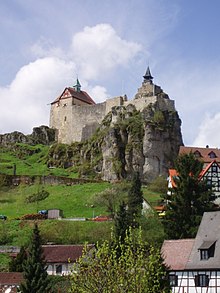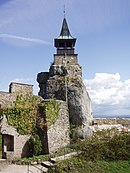Hohenstein Castle (Middle Franconia)
| Hohenstein Castle | ||
|---|---|---|
|
Hohenstein Castle in the Hersbrucker Alb |
||
| Creation time : | 11th century | |
| Castle type : | Höhenburg, rocky location | |
| Conservation status: | Considerable leftovers | |
| Place: | Hohenstein | |
| Geographical location | 49 ° 35 '12 " N , 11 ° 25' 22" E | |
|
|
||
The Burg Hohenstein is located on the western edge of Hohenstein , a small town in the Franconian Alb belonging Hersbrucker Alb .
It is one of the most striking architectural monuments in the Nuremberg region . After the castle had been left to decay for decades in the first half of the 19th century, it is now renovated and accessible again (see current use).
Geographical location
The rock castle is located on the western outskirts of Hohenstein, the second highest village in Middle Franconia , in the municipality of Kirchensittenbach . Its location is the summit plateau of the Hohenstein , which at 624 meters forms the highest point in the part of the Hersbrucker Alb north-west of the Pegnitz . The castle is based on this 30 meter high dolomite rock that slopes almost vertically on three sides. It is the most distinctive landmark of this region, at the same time it is also one of the best viewpoints in the area.
history
The making of the castle
The first beginnings of Hohenstein Castle probably go back to the 11th century. The first documentary mention, however, can only be proven for the year 1163, when a certain Sicolinus von Hohenstein was appointed as bailiff. In the centuries that followed, there were several changes in the rulership structure: It was initially owned by the Staufers from the Sulzbach counts . Derived from the name used earlier for this royal dynasty, Hohenstein Castle is now also sometimes referred to as Hohenstaufenburg . Later it came into the possession of the Wittelsbachers , the Luxembourgers and, in the end, back into the hands of the Bavarian dukes.
The transition to the imperial city of Nuremberg
In connection with the Landshut War of Succession , the imperial city of Nuremberg was finally able to secure rule over the castle and purchase it in 1505. In the following years it played an important role in the further history of Nuremberg . It was designated as the administrative seat of the newly created Hohenstein nursing office , where a nurse from Nuremberg resided. It was then important in the administration and defense of the newly acquired Nuremberg land area. However, this was her undoing half a century later in the Second Margrave War . Because the troops of the Nuremberg arch enemy, the Brandenburg-Kulmbach margrave Albrecht Alcibiades of Brandenburg-Kulmbach , were able to capture and destroy the fortress, which is so important for Nuremberg. Despite severe devastation, the imperial city and its allies were able to hold their own against the margrave in this war. Hohenstein Castle then remained undisputed in Nuremberg's possession and was rebuilt in the following period, although this dragged on into the 17th century.
The ruin of the castle complex
The decisive turning point in the history of the castle took place in 1806, when the history of Nuremberg as an imperial city came to an end. Together with the rest of the land of Nuremberg and the city itself, it was taken over by the Kingdom of Bavaria that year . This started the ruin of the castle complex, because parts of the castle were now sold for demolition by the state. The castle degenerated into becoming the quarry and among other things, the dungeon was this misappropriation victim. It was not until the middle of the 19th century that a certain rethinking began and attempts were made to stop the further decline. Part of the castle itself, the chapel building in 1901 by the Hohenstein u. Environment eV acquired u. renovated. In 1983, the remaining part of the castle was acquired by the Beautification Association and extensively renovated (for example the south wall of the Palas which collapsed in the night of February 28, 2000. It had previously shown inconspicuous deformations). The facility is now a listed building.
Todays use
In addition to visiting the castle, weddings in the chapel and civil weddings in the castle parlor are possible there. In one part of the complex, the so-called Long House, which the association acquired in 2005, cultural events as well as seminars and meetings are possible after its extensive renovation.
photos
literature
- Birgit Friedel: Kirchensittenbach: The Hohenstein Castle . In: Alfried Wieczorek (Hrsg.): Excursions to archeology, history and culture in Germany, Volume 52: Nuremberg and Nürnberger Land - excursion destinations between Pegnitz and Franconian Alb . Konrad Theiss Verlag, Stuttgart 2010, ISBN 978-3-8062-2368-2 , pp. 168-170.
- Robert Giersch, Andreas Schlunk, Berthold Frhr. von Haller: Castles and mansions in the Nuremberg countryside - a historical handbook based on preliminary work by Dr. Gustav Voit. Self-published by the Altnürnberger Landschaft e. V., Lauf an der Pegnitz 2006, ISBN 978-3-00-020677-1 , pp. 203-208.
- Ursula Pfistermeister : Well-defended Franconia - Volume 1: Castles, fortified churches, city walls around Nuremberg. Hans Carl Verlag, Nuremberg 2000, ISBN 3-418-00384-2 , pp. 57-58.
- Ruth Bach-Damaskinos, Jürgen Schnabel, Sabine Kothes: Palaces and castles in Middle Franconia. Verlag A. Hoffmann, Nuremberg 1993, ISBN 3-87191-186-0 , pp. 24-25.
- Walter Heinz: Former castles in the vicinity of Rothenberg - A selection, 2nd part: From Hohenstein to Keilberg. ( From Rothenberg and its surroundings , issue 15/2). Schnaittach 1992, pp. 71-101.
- Walter Heinz, Horst M. Auer (Hrsg.): Location history Franconia - excursions into the past. ars vivendi Verlag, Cadolzburg 2001, ISBN 3-89716-232-6 .
- Wilhelm Schwemmer: The art monuments of Middle Franconia, Volume X. District of Hersbruck. R. Oldenbourg Verlag, Munich 1959, pp. 184-190.
Web links
- http://www.burg-hohenstein.com/
- Castle side of the Altnürnberger Landschaft e. V.
- Hohenstein castle ruins on the homepage of the House of Bavarian History (plans, history, building history, existing buildings)
- Historical information about Hohenstein Castle
- Location of Hohenstein Castle in the Bavaria Atlas (accessed on October 16, 2016)
Individual evidence
- ↑ Map services ( Memento of the original from December 19, 2012 in the Internet Archive ) Info: The archive link has been inserted automatically and has not yet been checked. Please check the original and archive link according to the instructions and then remove this notice. of the BfN












